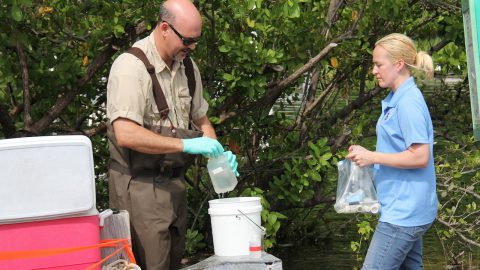On September 29th, researchers from AOML’s Environmental Microbiology Lab along with scientists from Florida International University’s Southeast Environmental Research Center collected water samples along Miami Beach during a king tide event, the highest astronomical tide of the year. Sample sites were located adjacent to pumps installed by the City of Miami Beach to actively pump super-tidal floodwaters out of the streets and back into Biscayne Bay. AOML’s team continuously monitored and collected water samples over a 5-hour period at locations in Maurice Gibb Memorial Park, along 14th Street, and at 27th Street and Indian Creek Drive. During sampling, physical water properties such as temperature, salinity, pH, turbidity, and dissolved oxygen content were also measured. For more on this sampling effort, read the web story.
Photo credit: NOAA
Image Captions
From Left:
- King tide flood waters inundate parts of Indian Creek Dr. in Miami Beach. Image credit: NOAA
- Scientists from FAU and AOML collect water samples at a pumping location along Indian Creek Dr. Image credit: NOAA
- Scientists bottle a sample collected from floodwaters being pumped back into Biscayne Bay. Image credit: NOAA
- Scientists bottle samples collected from floodwaters being pumped back into Biscayne Bay. Image credit: NOAA
- Vehicles submerged in king tide flood waters near Indian Creek Dr. Image credit: NOAA
- Scientist collects a water sample from a pump location along Indian Creek Dr. Image credit: NOAA
- Vehicles submerged in king tide flood waters near Indian Creek Dr. Image credit: NOAA
- King tide flood waters inundate portions of Collins Avenue Miami Beach. Image credit: NOAA
- King tide flood waters inundate portions of Collins Avenue Miami Beach. Image credit: NOAA









